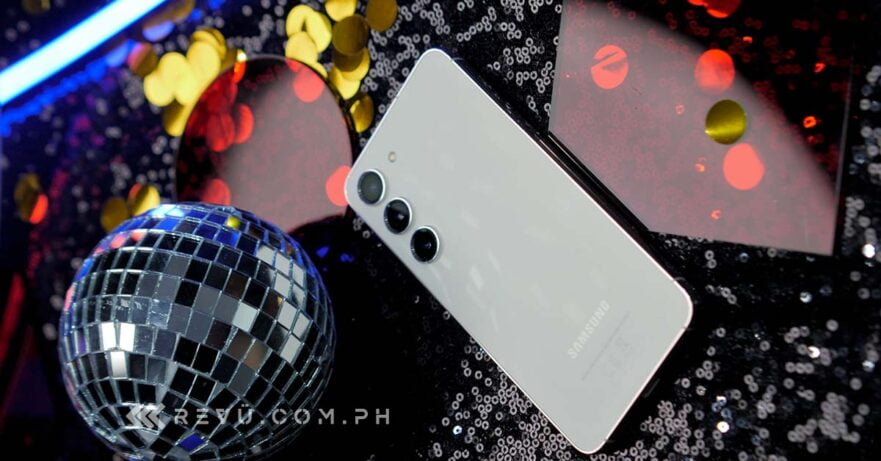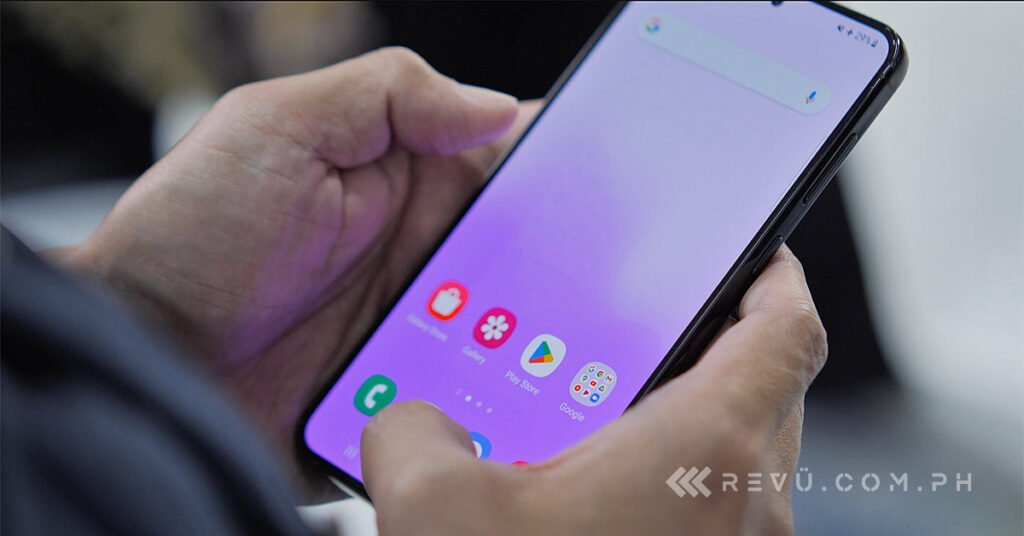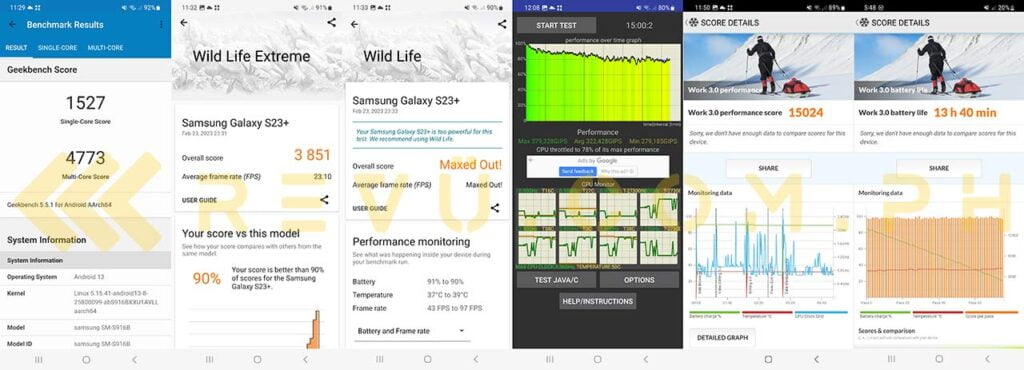Another year, another set of Galaxy flagships. Samsung is once again offering three premium smartphones: the base Galaxy S23, the larger Galaxy S23 Plus, and the highest-end Galaxy S23 Ultra with the best set of cameras.
This review will focus on the Samsung Galaxy S23 and Galaxy S23 Plus. These two are similar enough in hardware to warrant a combined review. Their user experience is nearly identical, save for the bigger display, storage, and battery of the Plus model.
Like last year’s Galaxy S22 series, the S23 lineup has top-of-the-line specifications: Qualcomm’s latest and greatest Snapdragon 8 Gen 2 processor, Samsung’s signature AMOLED panels, and a complete triple-camera array.
They also carry premium pricing. The base Galaxy S23 starts at P53,990 ($985) for 128GB of storage, while the Galaxy S23 Plus begins at P68,990 ($1,259) for 256GB of storage. These prices aren’t nearly as jaw-dropping as they once were a couple of years ago, but they do warrant more thought before committing to an upgrade.
The preview video we posted on February 2
Recycling a successful design
The Galaxy S23 series doesn’t look much different from its predecessor. The most notable distinction is in the rear camera bump. The newer generation removes the camera’s island completely, allowing the three cameras to protrude individually from the glass back. It’s a cleaner look that reduces wobble on a flat surface.
The aluminum frame is slightly curved, providing a smoother grip in hand. Combined with the matte finish of the rear glass, the Galaxy S23 and Galaxy S23 Plus are easier to hold if you choose to go case-less. At this point, it’s important to note there’s no silicone case or charger in the box. You only get a USB-C cable and SIM ejector.
The key difference between the S23 and S23 Plus is in the display size. The former offers a more pocketable 6.1-inch panel, while the latter owns a larger 6.6-inch screen. They both have a 1,080 x 2,340-pixel resolution, 120Hz refresh rate, and 240Hz touch-sampling rate. Picking between the two comes down to your sizing preference and budget. We would personally prefer the Plus variant for gaming and media consumption.

Apologies for the quality of this image; this is only a screenshot of a video we took of the two Galaxy phones. We just want to show you how their screen size compares
Samsung brought back its ultrasonic under-display fingerprint sensor. It’s a tad slow compared to the optical sensors we’ve used in other smartphone brands, but more secure and accurate in most cases. It’s also placed higher on the screen than we would’ve liked. Other welcome features are Dolby Atmos-equipped stereo speakers with lots of boom and IP68-certified resistance against some water or dust.
Grounded Galaxy experience
Samsung’s AMOLED panel once again takes center stage. It’s bright at up to 1,750 nits, supports HDR10+, and delivers true blacks. We were also happy to find symmetrical bezels from top to bottom, side to side. Together with the extra-loud pair of speakers, watching shows on YouTube and Netflix was a fantastic experience. Naturally, we enjoyed it more on the larger Samsung Galaxy S23 Plus.
Even though the Galaxy S23 lineup comes with Android 13, the company’s own OneUI 5.1 software runs the show. It offers a host of useful features like Always On Display and theme customization, plus conveniences like Modes/Routines to follow your everyday lifestyle and Advanced Features for adding gestures or multitasking windows. At the same time, the interface takes a lot of getting used to if you come from a non-Samsung device.
For example, the app drawer must be scrolled sideways, and the Settings menu feels convoluted — options are scattered across multiple menus, forcing you to rely on the search function most of the time. Samsung also didn’t implement certain Android 13 design cues, such as splash art in the notification panel and lock screen for whatever’s playing in the background, as well as the more streamlined audio adjustments. We still appreciate the consistent inclusion of Samsung DeX to connect the phone to a monitor for desktop mode, and support for up to four years of Android updates and five years of security patches.
The Galaxy S23 series doesn’t bundle a charging brick, but you can use any charger that supports the Power Delivery standard to maximize the charging speed. We used a 45-watt charger for our tests. The Galaxy S23 went to full from zero in one hour and 12 minutes, while the Galaxy S23 Plus hit the same mark in one hour and 10 minutes. Although the regular S23 has a smaller 3,900mAh battery compared to the S23 Plus’ 4,700mAh, it only accepts up to 25 watts, hence the nearly identical charging speed.
A beefed-up Snapdragon
All Galaxy S23 variants run on the same Snapdragon 8 Gen 2 chipset — no Exynos model this time. As a bonus, Samsung had this chipset customized for higher clock speeds. Our benchmark tests show the Galaxy S23 and Galaxy S23 Plus are indeed faster than smartphones outfitted with the regular Snapdragon 8 Gen 2. We can safely say the Galaxy S23 lineup has the fastest selection of non-gamer-centric Androids currently available in the market.
This isn’t to say the Galaxy S23 and Galaxy S23 Plus can’t slay any mobile game, however. We put them to the test by maxing out the graphics for Genshin Impact, and they both managed the load without much trouble at 60 frames per second. On the other hand, we noticed throttling after about 10 minutes of playtime on the regular S23 and even earlier than that on the S23 Plus. This led to some gameplay stutter and a warmer back panel. Fortunately, the battery endurance is much improved over the S22 series, as proven by our benchmarks and day-to-day usage.
To our surprise, Samsung doesn’t sell an S23 or S23 Plus model with more than 8GB of RAM. Although the Galaxy S23 Ultra goes up to 12GB, we would’ve expected more RAM options from the other two variants. In addition, the 128GB storage version of the base S23 utilizes the older UFS 3.1 specification. Only the 256GB storage version has UFS 4.0, which is twice as fast and nearly 50% more efficient than its predecessor.
Cameras for any situation
Samsung carried over its Galaxy S22 cameras to this generation. On the rear, the S23 and S23 Plus have the same 50-megapixel main, 12-megapixel ultrawide, and 10-megapixel telephoto cameras. Their front camera has been upgraded to a 12-megapixel sensor from last year’s 10-megapixel unit.
If you’ve used Samsung’s flagship-level shooters before, nothing would surprise you here. It’s the usual fare: highly saturated photos with lots of sharpening and a wide dynamic range. The rear cameras tend to overdo it at times, to the point of appearing artificial, but they look great on social media and can easily be desaturated using any photo-editing app. The same goes for selfies; you have the option to weaken the punch if the strong colors don’t suit your taste.
Shot on the Samsung Galaxy S23 Plus
Shot on the Samsung Galaxy S23. Again, the two smartphones have the same camera systems
The camera app and its options are the same as before, too. Portrait mode automatically uses the 3X zoom of the telephoto module for better background blur. Video mode allows up to 8K resolution recording at 30fps or down to 4K if you prefer a smoother 60fps. Finally, Photo mode has a 50MP option hidden inside the aspect ratio selection to truly maximize the main camera sensor. You can find the Night, Panorama, and other scene-specific modes under the More tab.
Final thoughts
Those coming from a Galaxy S22 series or even S21 series phone won’t find much reason to upgrade to the S23 or S23 Plus. Samsung didn’t exert much effort into revising the design, and the cameras and displays are nearly identical.
The main advantage is in the new Snapdragon processor, upgraded specifically for these Galaxies. This chipset is more powerful and efficient. The only limiting factor is the 8GB of RAM and slower storage specification of the cheapest 128GB model, if those matter to you in the long run.
In the Philippines, the colors for both S23 models are limited to Phantom Black, Cream, Green, and Lavender. Again, there’s no included charger or case for either variant, so you’d have to factor those into your budget.

‘The main advantage is in the new Snapdragon processor, upgraded specifically for these Galaxies. This chipset is more powerful and efficient’
— Marvin Velasco
Samsung Galaxy S23 specs
- 6.1-inch 1080p AMOLED, 120Hz refresh rate, 240Hz touch-sampling rate
- Qualcomm Snapdragon 8 Gen 2 processor
- 8GB RAM
- 128GB/256GB storage
- 50-megapixel main, 12-megapixel ultrawide, 10-megapixel telephoto rear cameras
- 12-megapixel front camera
- Under-display fingerprint sensor
- Stereo speakers
- 3,900mAh battery
- 25-watt wired charging, 15-watt wireless charging, 4.5-watt reverse wireless charging
- OneUI 5.1 based on Android 13
- IP68 dust and water resistance
- Color options: Phantom Black, Cream, Green, Lavender
Samsung Galaxy S23 Plus specs
- 6.6-inch 1080p AMOLED, 120Hz refresh rate, 240Hz touch-sampling rate
- Qualcomm Snapdragon 8 Gen 2 processor
- 8GB RAM
- 256GB/512GB storage
- 50-megapixel main, 12-megapixel ultrawide, 10-megapixel telephoto rear cameras
- 12-megapixel front camera
- Under-display fingerprint sensor
- Stereo speakers
- 4,700mAh battery
- 45-watt wired charging, 15-watt wireless charging, 4.5-watt reverse wireless charging
- IP68 dust and water resistance
- OneUI 5.1 based on Android 13
- Color options: Phantom Black, Cream, Green, Lavender
(We used the Samsung Galaxy S23 Ultra to take photos and videos of devices at Mobile World Congress 2023 in Barcelona, Spain. Our verdict on the Korean technology giant’s most premium flagship should be up soon. — AUG)
Share this Post


































